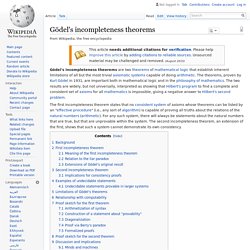

Logic. Logic (from the Ancient Greek: λογική, logike)[1] is the branch of philosophy concerned with the use and study of valid reasoning.[2][3] The study of logic also features prominently in mathematics and computer science.

Logic is often divided into three parts: inductive reasoning, abductive reasoning, and deductive reasoning. The study of logic[edit] The concept of logical form is central to logic, it being held that the validity of an argument is determined by its logical form, not by its content. Traditional Aristotelian syllogistic logic and modern symbolic logic are examples of formal logics. Informal logic is the study of natural language arguments. Logical form[edit] Main article: Logical form Logic is generally considered formal when it analyzes and represents the form of any valid argument type. This is called showing the logical form of the argument. Second, certain parts of the sentence must be replaced with schematic letters. From an observed surprising circumstance from. Laws of Form weblog. Multiple Form Logic: An extension of George Spencer-Brown's LAWS of FORM. ATTENTION: Best viewed with Mozilla ™ or Netscape ™, 1280 x 1024 resolution.
An enhanced generalisation of George Spencer Brown 's " Laws of Form ", simplifying & elucidating Propositional Logic and the Philosophy of Logic. This site also includes some Automatic Theorem Proving Software (you can download) written in Visual Prolog ™ and LPA Win-Prolog ™ Last update: 5 October 2007 (version 1.8) CONTENTS: (1) "Laws of Form" and the unknown history of Multiple Form Logic ™ George Spencer-Brown's " Laws of Form " is a revolutionary book about Logic, which influenced many researchers and artists in the world, for about three decades. The " Laws of Multiple Form " (or Multiple Form Logic™ or " Calculus of Multiple Distinctions ") is a Logic Calculus that resembles Bricken's modifications of " Laws of Form " , but it is much more generalised.
. (2) The Three Fundamental Axioms of Multiple Form Logic™ William Bricken used three axioms in his system. 1) Dominion A ( ) = () 2) Involution ( ( A ) ) = A. Gödel's incompleteness theorems. Gödel's incompleteness theorems are two theorems of mathematical logic that establish inherent limitations of all but the most trivial axiomatic systems capable of doing arithmetic.

The theorems, proven by Kurt Gödel in 1931, are important both in mathematical logic and in the philosophy of mathematics. The two results are widely, but not universally, interpreted as showing that Hilbert's program to find a complete and consistent set of axioms for all mathematics is impossible, giving a negative answer to Hilbert's second problem. The first incompleteness theorem states that no consistent system of axioms whose theorems can be listed by an "effective procedure" (i.e., any sort of algorithm) is capable of proving all truths about the relations of the natural numbers (arithmetic). For any such system, there will always be statements about the natural numbers that are true, but that are unprovable within the system. Background[edit] First incompleteness theorem[edit] Diagonalization[edit] B. Hilbert's second problem. In mathematics, Hilbert's second problem was posed by David Hilbert in 1900 as one of his 23 problems.

It asks for a proof that arithmetic is consistent – free of any internal contradictions. In the 1930s, Kurt Gödel and Gerhard Gentzen proved results that cast new light on the problem. Some feel that these results resolved the problem, while others feel that the problem is still open. Hilbert's problem and its interpretation[edit] In one English translation, Hilbert asks: "When we are engaged in investigating the foundations of a science, we must set up a system of axioms which contains an exact and complete description of the relations subsisting between the elementary ideas of that science. ...
It is now common to interpret Hilbert's second question as asking in particular for a proof that Peano arithmetic is consistent. There are many known proofs that Peano arithmetic is consistent that can be carried out in strong systems such as Zermelo-Fraenkel set theory. See also[edit]